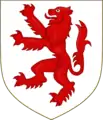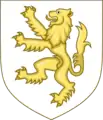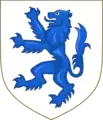Míl Espáine
In Irish origin myths, Míl Espáine or Míl Espáne (later Latinized as Milesius; also Miled/Miledh) is the mythical ancestor of the final inhabitants of Ireland, the "sons of Míl" or Milesians, who represent the vast majority of the Irish Gaels. His father was Bile, son of Breogan.
Etymology
His name is described by Mark Williams as an "etymological fiction"[1] translated from the Latin Miles Hispaniae, meaning "Soldier of Hispania", which is attested in a passage (§ 13) in the 9th-century pseudo-historical work Historia Brittonum ("The History of the Britons") by Nennius.[2] According to the Lebor Gabála Érenn or the Book of Invasions where this tale is recorded his real name is Galam which is equivalent to Columba and its derivatives such as Malcolm and Callum.
Biography
The work offers an account of how Ireland was successively taken by settlers from Spain, among them Partholom, Nimeth and the "three sons of a Hispanic soldier" (tres filii militis Hispaniae).[3] As A.G. van Hamel has suggested, the status of Iberia as the land of origin can be traced back to Isidore of Seville, who in the introduction to his history of the Goths, Vandals and Suebi had elevated Spain to the "mother of all races".[4] A further explanation may lie in the mistake made by some classical geographers in locating Ireland closely opposite Iberia. For instance, the Lebar Gabála (§ 100) recounts that from Bregon's Tower, the Milesian Íth was able to see right across the sea to Ireland. In galician history, that tower is the Torre de Hercules, Hercule Tower, in A Coruña, Galicia.[5]
He served as a soldier in Scythia and Egypt, before remembering a prophecy that his descendants would rule Ireland. He set off to the west, getting as far as Iberia where he fought several battles before dying, never seeing Ireland himself.
His wife Scota and his uncle Íth, who had spied Ireland from a tower, sailed to Ireland where Íth was killed by the Tuatha Dé Danann. When his body was brought back to Iberia, Míl's eight sons and Íth's nine brothers invaded Ireland and defeated the Tuatha Dé Danann. He figures prominently in the traditional genealogies of John O'Hart.
Milesius died in Spain before he could reach the Isle of Destiny. His wife Scota went to Ireland with their eight sons. On account of some terrible storms (attributed to the magic of the Tuatha Dé Danann who already lived in Ireland) most of Milesius' sons died when they tried to land.
Offspring and progeny
Among the sons of Milesius in Ireland were Heber Fionn, Heremon, Ir (whose son was Heber Donn) and Amergin Glúingel. The traditional genealogies of Gaelic Ireland and Gaelic Scotland trace the ancestors of the Gaels back to one of the first three sons. Typically, the descendants of Heber Fionn were prominent in Munster (including the Eóganachta, Corcu Loígde, Uí Fidgenti and Uí Liatháin), the progeny of Ir, through his son Heber Donn formed the bulk of Ulster (including the Ulaidh; Dál nAraidi, Conmhaícne, Ciarraige and Corco Mruad) and then offspring of Heremon were most powerful in Connacht, Leinster and parts of Ulster (including the Connachta, Uí Néill, Clan Colla, Uí Maine, Laighin, Dalcassians and the Érainn).[6]
In his younger days, Milesius, while travelling through Africa iss said to have killed three lions and subsequently bore three lions as his symbol. Each of the lions were bore by his progeny: Heber Donn and Heremon (as well as their descendants), bore the gold and red lions respectively, while his grandson, Heber Donn bore the blue lion.[6]
 Lion of Heremon.
Lion of Heremon. Lion of Heber Fionn.
Lion of Heber Fionn. Lion of Heber Donn.
Lion of Heber Donn.
See also
References
Footnotes
- Williams, Mark (2018). Ireland's Immortals: A History of the Gods of Irish Myth. Princeton University Press. p. 139. ISBN 978-0-691-18304-6. Retrieved 2 July 2020.
- Lennon, Joseph (2008). Irish Orientalism: A Literary and Intellectual History. Syracuse University Press. pp. 24, 35. ISBN 978-0-8156-3164-4. Retrieved 2 July 2020.
- Carey, Irish National Origin Legend, pp. 5-6.
- Van Hamel, "On Lebor Gábala", p. 173.
- Hellmuth, "Míl Espáine"
- The Stem of the Irish Nation - Irish Pedigrees
Bibliography
- O'Neill, Desmond (1996). The Ancient and Royal Family of O'Neill. Meath. ISBN 0-9524484-1-6.
- R.A.S. Macalister (ed.). Lebor Gabála Érenn [The Book of the Taking of Ireland]. Dublin: Irish Texts Society.
- Carey, John (1994). The Irish National Origin-Legend: Synthetic Pseudohistory (PDF). Quiggin Pamphlets on the Sources of Mediaeval Gaelic History 1. Cambridge.
- Hamel, A.G. van (1914–1915). "On Lebor Gabála". Zeitschrift für celtische Philologie. 10: 97–197.
- Hellmuth, Petra S. (2006). "Míl Espáine and the Milesians". In Koch, John T. (ed.). Celtic Culture: A Historical Encyclopedia. Santa Barbara, Denver, and Oxford: ABC-CLIO. p. 1298.
- Tochomlod mac Miledh a hEspain i nErind ("The Progress of the Sons of Míl from Spain to Ireland"), ed. and tr. M.E. Dobbs (1937). "Tochomlad mac Miledh a hEspain i nErind: no Cath Tailten?". Études Celtiques. 2 (3): 50–91. doi:10.3406/ecelt.1937.1133.
- The Milesian Invasion of Ireland, ed. and tr. Hull, Vernam (1931–1933). "The Milesian Invasion of Ireland". ZCP. 19: 155–60.
- Carey, John (1995). "Native Elements in Irish Pseudo-History". In Doris Edel (ed.). Cultural Identity and Cultural Integration: Ireland and Europe in the Early Middle Ages. Dublin: Four Courts. pp. 45–60.